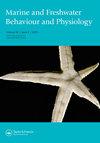神经蝌蚪对昆虫捕食者没有察觉和反应
IF 1.1
4区 生物学
Q3 MARINE & FRESHWATER BIOLOGY
Marine and Freshwater Behaviour and Physiology
Pub Date : 2022-10-19
DOI:10.1080/10236244.2022.2135438
引用次数: 0
摘要
被捕食动物利用各种信号来探测它们的捕食者,并做出相应的反应,以提高它们的生存能力。由于对捕食者的反应是昂贵的,被捕食物种可能会通过使用其他策略来降低成本,例如行为策略、形态变化、寻求自然避难所或获得独特的栖息地。尼法马里小蝌蚪的身体是透明的,生活在一个神经环境中,这为它们抵御底栖动物的捕食提供了保护。因此,我们利用来自昆虫捕食者蜻蜓幼虫的不同线索,研究了M. nilphamariensis蝌蚪的捕食者识别机制,以确定自然庇护和独特栖息地获取的存在是否影响该物种捕食者识别的化学生态学。我们还将这些蝌蚪暴露在活跃的笼中捕食者和应激激素皮质酮(CORT)中,以研究它们对警报提示的行为反捕食者反应的生理机制。在捕食者躲避实验中,nilphamariensis蝌蚪不使用视觉或化学信号对捕食者做出反应。蝌蚪对捕食者释放的警报、异种、kairomones和饮食线索没有改变它们的活动。不同浓度的CORT对nilphamariensis蝌蚪的报警反应也没有影响。这些结果清楚地表明,nilphamariensis的神经元蝌蚪对共存的昆虫捕食者没有检测和响应。我们在这些被捕食的蝌蚪所占据的独特栖息地,交替猎物的存在以及诸如透明身体等固有因素的背景下讨论这些结果。本文章由计算机程序翻译,如有差异,请以英文原文为准。
Neustonic tadpoles do not detect and respond to insect predator
ABSTRACT Prey animals use various signals to detect their predators and respond accordingly to enhance their survival. Since responding to a predator is costly, prey species may cut cost by using other strategies such as behavioural tactics, morphological changes, seeking natural refuge or unique habitat acquisition. Tadpoles of Microhyla nilphamariensis have a transparent body and live in a neustonic environment, which provides them protection against benthic predators. As a result, we investigated the predator detection mechanism in M. nilphamariensis tadpoles using different cues from an insect predator, dragonfly larvae, to determine if the presence of natural shelter and unique habitat acquisition influences the chemo-ecology of predator recognition in this species. We also exposed these tadpoles to active caged predators and a stress hormone, corticosterone (CORT) to study physiological mechanism underlying their behavioural anti-predator responses toward alarm cues. In the predator avoidance assay, M. nilphamariensis tadpoles did not respond to the predator using visual or chemical signals. The tadpoles did not change their activity in response to alarm, heterospecific, kairomones, and dietary cues released from the predator. Pre-conditioning of M. nilphamariensis tadpoles with caged predator and different concentrations of CORT also did not alter their activity in response to alarm cues. These results clearly demonstrated that neustonic tadpoles of M. nilphamariensis do not detect and respond to co-existing insect predator. We discuss these results in the context of unique habitat occupied by these prey tadpoles, the presence of alternate prey, and inherent factors such as transparent body.
求助全文
通过发布文献求助,成功后即可免费获取论文全文。
去求助
来源期刊

Marine and Freshwater Behaviour and Physiology
生物-海洋与淡水生物学
CiteScore
2.10
自引率
0.00%
发文量
9
审稿时长
>12 weeks
期刊介绍:
Marine and Freshwater Behaviour and Physiology is devoted to the publication of papers covering field and laboratory research into all aspects of the behaviour and physiology of all marine and freshwater animals within the contexts of ecology, evolution and conservation.
As the living resources of the world’s oceans, rivers and lakes are attracting increasing attention as food sources for humans and for their role in global ecology, the journal will also publish the results of research in the areas of fisheries biology and technology where the behaviour and physiology described have clear links to the contexts mentioned above.
The journal will accept for publication Research Articles, Reviews, Rapid Communications and Technical Notes (see Instructions for authors for details). In addition, Editorials, Opinions and Book Reviews (invited and suggested) will also occasionally be published. Suggestions to the Editor-In-Chief for Special Issues are encouraged and will be considered on an ad hoc basis.
With the goal of supporting early career researchers, the journal particularly invites submissions from graduate students and post-doctoral researchers. In addition to recognising the time constraints and logistical limitations their research often faces, and their particular need for a prompt review process, accepted articles by such researchers will be given prominence within the journal (see Instructions for authors for details).
 求助内容:
求助内容: 应助结果提醒方式:
应助结果提醒方式:


